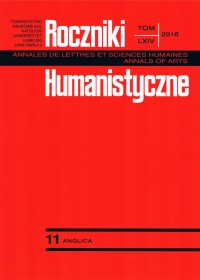Is multi-noun compounding a productive process in English?
Abstrakt
Złożenia w języku angielskim stanowią częsty przedmiot analizy morfologicznej. Dotychczasowe badania językoznawcze koncentrowały się głównie na złożeniach zawierających tylko dwa elementy; przedmiotem tego artykułu są angielskie złożenia wieloczłonowe. Dane korpusowe wskazują na dużą rozbieżność między liczbą złożeń dwuczłonowych i wieloczłonowych. Wynika z nich, że o ile wysoka produktywność złożeń dwuczłonowych nie podlega dyskusji, złożenia wieloczłonowe występują znacznie rzadziej. Głównym celem artykułu jest wskazanie przyczyn niskiej częstotliwości złożeń wieloczłonowych, szczególnie tych zbudowanych z więcej niż trzech rzeczowników. Badając korpus języka angielskiego pod kątem złożeń można wnioskować, że złożenia wieloczłonowe składają się w dużej mierze ze zleksykalizowanych elementów, oraz że zarezerwowane są przede wszystkim dla tych rejestrów językowych, które wymagają formułowania zwięzłych komunikatów. Zleksykalizowane złożenia dwuczłonowe często stanowią bazę dla konstrukcji zbudowanych z większej ilości rzeczowników. Rzadkość występowania złożeń wieloczłonowych jest więc rezultatem niskiej liczby wysoce zleksykalizowanych złożeń dwuczłonowych, które mogłyby stanowić podstawę dla dłuższych złożeń. Niska częstotliwość złożeń wieloczłonowych nie ma znaczenia dla ogólnej produktywności złożeń w języku angielskim, jako że proces ich powstawania jest identyczny jak w przypadku złożeń dwuczłonowych.
Artykuł koncentruje się na złożeniach endocentrycznych, jako że stanowią one najbardziej liczną i produktywną podgrupę złożeń.
Bibliografia
Adams, Valerie. 1973. An introduction to modern English word-formation. English. Language Series 7. London: Longman.
Adams, Valerie. 2001. Complex Words in English. Harlow: Longman.
Bauer, Laurie. 1998. Vocabulary. London and New York: Routledge.
Bauer, Laurie. 2003. Introducing linguistic morphology. 2nd ed. Edinburgh: Edinburgh University Press.
Crystal, David. 1998. Language play. Harmondsworth: Penguin.
DiSciullo, Anna Maria, and Edwin Williams. 1987. On the definition of word. Cambridge, MA: The MIT Press.
Downing, Pamela. 1977. “On the creation and use of English compound nouns.” Language 53(4): 810–842.
Fabb, Nigel. 1998. “Compounding.” In The Handbook of Morphology, edited by Andrew Spencer and Arnold Zwicky, 66-83. Oxford: Blackwell Publishers Ltd.
Fletcher, William (2003-2010). Phrases in English. http://phrasesinenglish.org (accessed 12.12.2016).
Fudge, Erik. 1984. English Word-stress. London: George Allen & Unwin.
Giegerich, Heinz (2004). “Compound or Phrase? English noun-plus-noun constructions and the stress criterion.” English Language and Linguistics 8: 1–24.
Haspelmath, Martin. 2002. Understanding morphology. London: Arnold.
Jackendoff, Ray. 2009. “Compounding in the parallel architecture and conceptual semantics.” In The Oxford handbook of compounding, edited by Rochelle Lieber and Pavol Štekauer, 105–28. Oxford: Oxford University Press.
Jespersen, Otto. 1954. A modern English grammar. London: George Allen and Unwin.
Katamba, Francis. 1993. Morphology. London: Macmillan.
Kuiper, Koenraad. 1999. “Compounding by adjunction and its empirical consequences.” Language Sciences 21: 407–422.
Levi, Judith N. 1978. The syntax and semantics of complex nominals. New York: Academic Press.
Liberman, Mark, and Richard Sproat. 1992. “The Stress and Structure of Modified Noun Phrases in English.” In Lexical matters, edited by Ivan Sag and Anna Szabolcsi, 131-181. Stanford: Center for the Study of Language and Information.
Lieber, Rochelle. 2005. “English word-formation processes.” In Handbook of Word-formation, edited by Rochelle Lieber and Pavol Štekauer, 375–427. Dordrecht: Springer.
Lieber, Rochelle, and Pavol Štekauer. 2009. “Introduction: Status and definition of compounding.” In The Oxford handbook of Compounding, edited by Rochelle Lieber and Pavol Štekauer, 105–28. Oxford: Oxford University Press.
Lipka, Leonhard (1992). “Lexicalization and institutionalization in English and German.” Linguistica Pragensia 1: 1-13. Or: Piefke, Wendehals, Smog, Perestroika, AIDS etc. Zeitshrift für Anglistik und Amerikanistik, 40, 101–111.
Marchand, Hans. 1967. “Expansion, transposition, and derivation.” La Linguistique 3(1): 13–26. Reprinted in: Studies in syntax and word-formation. Selected articles by Hans Marchand, edited by Dieter Kastovsky, 322–337. München: Wilhelm Fink.
Plag, Ingo. 2003. Word-formation in English. Cambridge textbooks in linguistics. Cambridge: Cambridge University Press.
Plag, Ingo. 2006. “The variability of compound stress in English: structural, semantic and analogical factors.” English Language and Linguistics 10(1): 143–172.
Schultink, Henk. 1961. “Produktiviteit als morphologisch fenomeen.” Forum der Letteren 2: 110–125.
Schmerling, Susan F. 1971. “A stress mess.” Studies in the Linguistic Sciences 1: 52–65.
Selkirk, Elisabeth O. 1982. The syntax of words. Cambridge, MA: MIT Press.
Spencer, Andrew. 2003. “Does English have productive compounding?” In B. Gert, J. DeCesaris, A. Ralli and S. Scalise (eds.), Topics in morphology. Selected papers from the third Mediterranean morphology meeting (Barcelona, September 20-22, 2001), edited by Geert Booij, Janet DeCesaris, Angela Ralli, Sergio Scalise, 329-341. Barcelona: Institut Universitari de Lingüística Applicada, Universtitat Pompeu Fabra.
Štekauer, Pavol. (2005). Meaning predictability in word formation: Novel, context-free naming units. Amsterdam: John Benjamins.
Szymanek, Bogdan. 1998. Introduction to morphological analysis. Warszawa: PWN.
The British National Corpus. (1980s-1993). (2013). Brigham Young University. http://corpus. byu.edu/bnc (accessed 12.12.2016).
The Corpus of Contemporary American English (1990-2012). (2013). Brigham Young University. http://corpus.byu.edu/coca (accessed 12.12.2016).
Warren, Beatrice. 1978. Semantic patterns of noun–Noun compounds. Gothenburg: Gothenburg University Press.
Zwicky, Arnold. 1986. “Forestress and afterstress.” Ohio State University Working Papers in Linguistics 32, 46–62.
Copyright (c) 2016 Roczniki Humanistyczne

Utwór dostępny jest na licencji Creative Commons Uznanie autorstwa – Użycie niekomercyjne – Bez utworów zależnych 4.0 Międzynarodowe.





